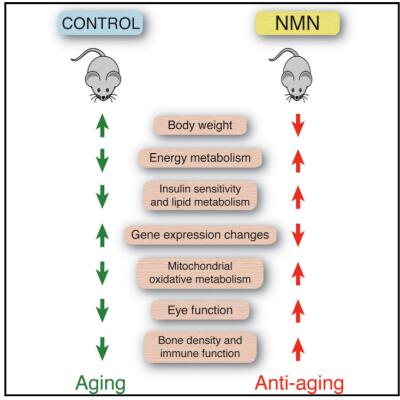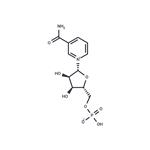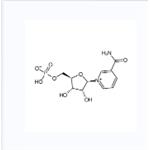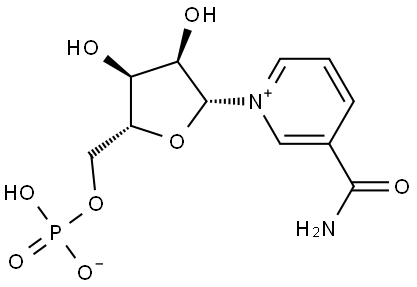What is β-Nicotinamide Mononucleotide?
Feb 21,2020
Nicotinamide adenine dinucleotide (NAD+) exists in all living organisms and is well known as a coenzyme in oxidation−reduction reaction. Recent research has drawn attention to its relation to “sirtuin” represented by NAD+−dependent protein deacetylases, which is to regulate various life phenomena as aging, people are especially paying high attention to “Anti-aging effect”. The turnover of the oxidized form of nicotinamide adenine dinucleotide (NAD+) has attracted interest in regard to longevity. Meanwhile, sirtuin is NAD+−dependent and increase of cellular NAD+ level is expected to have similar effects to the STACs, thus nicotinamide mononucleotide, an intermediate of NAD+ biosynthesis, is also in the spotlight [1].
Nicotinamide mononucleotide (NMN) has been shown to enhance NAD+ biosynthesis and ameliorate various pathologies in mouse disease models. In this study, researchers conducted a 12-month-long NMN administration to regular chow-fed wild-type mice during their normal aging (scheme 1). Orally administered NMN was quickly utilized to synthesize NAD+ in tissues. Remarkably, NMN effectively mitigates age-associated physiological decline in mice. Without any obvious toxicity or deleterious effects, NMN suppressed age-associated body weight gain, enhanced energy metabolism, promoted physical activity, improved insulin sensitivity and plasma lipid profile, and ameliorated eye function and other pathophysiologies. Consistent with these phenotypes, NMN prevented age-associated gene expression changes in key metabolic organs and enhanced mitochondrial oxidative metabolism and mitonuclear protein imbalance in skeletal muscle. These effects of NMN highlight the preventive and therapeutic potential of NAD+ intermediates as effective anti-aging interventions in humans [2].
NMN proved to be effective in treating high fat diet-induced type 2 diabetes, which is a chronic and progressive disease with continuously increasing prevalence and rising financial pressure on the worldwide healthcare systems. Recently, the insulin resistance, hallmark of type 2 diabetes, was cured in mice treated with NAD+ precursor β-nicotinamide mononucleotide (NMN), no toxic effects being reported. NAD+ is present in all living organisms and is a well-known coenzyme in oxidation-reduction reactions. NAD+−dependent protein deacetylases such as SIRT1 and SIRT6 serve as metabolic sensors, and regulate downstream pathways, which eventually restore mitochondrial function and insulin sensitivity [3]. The low cost of the growing media, simple and inexpensive process equipment required may lead to a price reduction of NMN to a level suitable for treating type 2 diabetes and aging related diseases in humans. This finding extends the research domain of NAD+ effects to other degenerative diseases associated with aging, such as: cardiovascular, cancer, arthritis, osteoporosis or Alzheimer’s diseases.

Scheme 1 Control experiment with and without Nicotinamide mononucleotide (NMN)
References
[1] https://www.oyc-bio.jp/products/view/nmn002
[2] Kathryn F. Mills, etc., Long-Term Administration of Nicotinamide Mononucleotide Mitigates Age-Associated Physiological Decline in Mice, Cell Metabolism 24, 795–806, December 13, 2016
[3] George Cătălin Marinescu, etc., β-nicotinamide mononucleotide (NMN) production in Escherichia coli, 16 August 2018, Scientific RePortS | (2018) 8:12278, 1-11.
- Related articles
- Related Qustion
- Why do some people stop taking β-Nicotinamide Mononucleotide supplements? May 16, 2025
β-Nicotinamide Mononucleotide (NMN), as a precursor of nicotinamide adenine dinucleotide (NAD), plays an important role in increasing NAD levels.
- β-Nicotinamide Mononucleotide: Benefits and Side Effects Jun 18, 2024
β-Nicotinamide Mononucleotide (NMN) is one of the key precursors of coenzyme I (NAD+). β-NMN is widely present in various organisms, and the β-isomer is its active form.
- Preparation of β-Nicotinamide Mononucleotide Jan 4, 2024
The one-step conversion of nicotinamide riboside (NR) to β-NMN has been considered to be the most promising synthetic route for β-NMN.
6-amino-2,2-dimethyl-4H-pyrido[3,2-b][1,4]oxazin-3-one is the key intermediate of Fostamatinib, which is a medication approved by the U.S. Food and Drug Administration since 2018 for the treatment of chronic immune thrombocytopenia (ITP).....
Feb 21,2020Organic Synthesis IntermediateTetrahydro-4-pyrone is used in organic synthesis as a building block for more complex chemical structures because it participates in a variety of cycloaddition reactions.....
Feb 21,2020Pharmaceutical intermediatesβ-Nicotinamide Mononucleotide
1094-61-7You may like
- D-glucuronic acid: production methods and application
Oct 13, 2025
- Application research of Hexapeptide 9
Sep 4, 2025
- The study of Fmoc-L-Arg(Pbf)-OH
Aug 15, 2025
β-Nicotinamide Mononucleotide manufacturers
- β-Nicotinamide mononucleotide
-

- $30.00 / 5mg
- 2025-12-13
- CAS:1094-61-7
- Min. Order:
- Purity: 99.66%
- Supply Ability: 10g
- NMN
-

- $1.00 / 1KG
- 2025-12-13
- CAS:1094-61-7
- Min. Order: 1000KG
- Purity: 99.99%
- Supply Ability: 20 TONS
- Beta-Nicotinamide Mononucleotide(NMN)
-

- $0.00 / 1kg
- 2025-12-13
- CAS:1094-61-7
- Min. Order: 1kg
- Purity: 99%
- Supply Ability: 20MT





